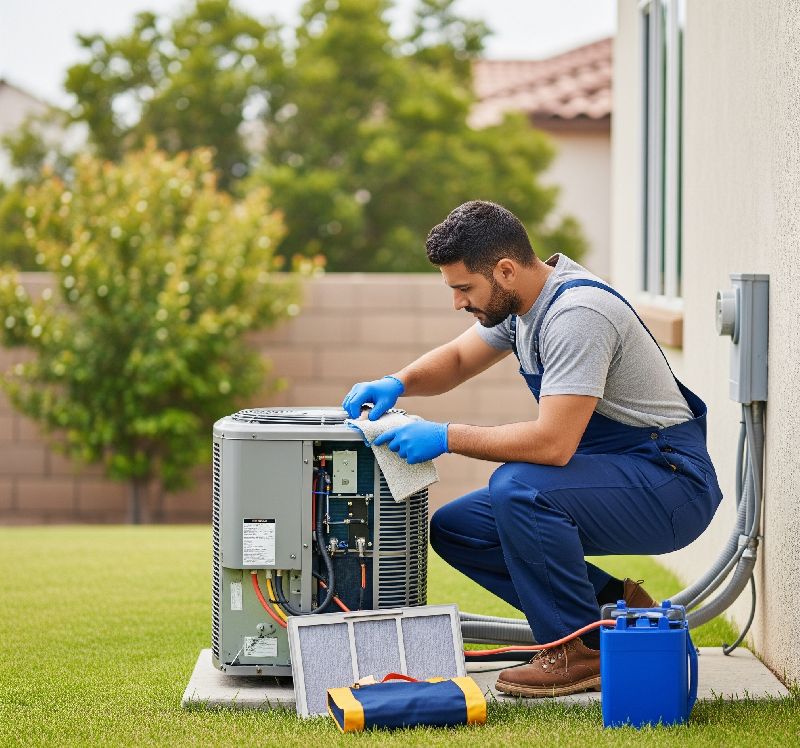I. Fundamentals and Safety
- Introduction to HVAC/R (Heating, Ventilation, Air Conditioning, and Refrigeration):
- Basic concepts of heating, cooling, and air quality.
- Importance of HVAC systems in residential, commercial, and industrial settings.
- Basic Science Principles:
- Thermodynamics (heat transfer, laws of thermodynamics).
- Properties of matter (states of matter, pressure, temperature).
- Humidity and psychrometrics (study of moist air).
- Safety Precautions and Procedures:
- Electrical safety (lockout/tagout, handling live circuits).
- Refrigerant handling safety (hazards, proper storage, disposal).
- Tool safety and personal protective equipment (PPE).
- Workplace safety regulations and first aid.
- Tools and Equipment:
- Identification and proper use of hand tools (wrenches, pliers, screwdrivers, tube cutters, flaring tools, swaging tools).
- Measuring instruments (multimeter, clamp meter, pressure gauges, thermometers).
- Specialized AC tools (vacuum pump, manifold gauge set, leak detectors, recovery machines).
II. Refrigeration Cycle and Components
- Vapor Compression Refrigeration Cycle:
- Detailed explanation of the four main components: compressor, condenser, expansion device, and evaporator.
- Understanding the refrigerant flow and phase changes.
- Superheating and subcooling concepts.
- Refrigerants:
- Types of refrigerants (CFCs, HCFCs, HFCs, HFOs, natural refrigerants).
- Environmental impact and regulations (e.g., Montreal Protocol, F-Gas Regulation).
- Refrigerant charging methods.
- Compressors:
- Types of compressors (reciprocating, rotary, scroll, screw, centrifugal).
- Construction, working principles, and applications of each type.
- Troubleshooting common compressor issues.
- Condensers:
- Types of condensers (air-cooled, water-cooled, evaporative).
- Function, construction, and maintenance.
- Evaporators:
- Types of evaporators (plate fin, bare tube, finned tube).
- Function, construction, and maintenance.
- Expansion Devices:
- Types of expansion devices (capillary tube, thermostatic expansion valve - TXV, automatic expansion valve - AXV, electronic expansion valve - EEV).
- Function and selection.
- Other Refrigeration Components:
- Driers/filter-driers, accumulators, receivers, oil separators.
III. Electrical Systems and Controls
- Basic Electricity:
- Concepts of voltage, current, resistance, and power.
- Ohm's Law and basic electrical circuits (series, parallel).
- AC and DC supply.
- Electrical Components in AC Systems:
- Motors (fan motors, compressor motors).
- Capacitors (start capacitors, run capacitors).
- Relays and contactors.
- Thermostats and other control devices (pressure switches, temperature sensors).
- Fuses and circuit breakers.
- Wiring Diagrams:
- Reading and interpreting electrical wiring diagrams for AC units.
- Tracing electrical circuits.
- Troubleshooting Electrical Faults:
- Using multimeters for voltage, current, and resistance checks.
- Identifying open circuits, short circuits, and ground faults.
- Diagnosing motor, capacitor, and control issues.
- Inverter AC Technology:
- Understanding the working principle of inverter ACs.
- Troubleshooting and repair of inverter systems.
IV. AC System Types and Installation
- Types of Air Conditioners:
- Window AC units.
- Split AC units (wall-mounted, floor-standing, cassette, ductable).
- Centralized AC systems.
- Package AC units.
- VRV/VRF systems.
- Automobile AC systems (often a specialized module).
- Installation Procedures:
- Site inspection and planning.
- Mounting indoor and outdoor units.
- Piping and ducting layout and installation (tube cutting, bending, flaring, swaging, brazing).
- Electrical connections.
- Leak testing (nitrogen pressure test).
- Evacuation (vacuuming the system).
- Refrigerant charging (weighing, superheat/subcool method).
- Commissioning and performance testing.
- Thermal insulation.
V. Maintenance and Troubleshooting
- Routine Maintenance Procedures:
- Cleaning indoor and outdoor coils.
- Cleaning/replacing air filters.
- Maintaining drain pans and lines to prevent blockages.
- Checking refrigerant levels.
- Lubrication of moving parts.
- Electrical system checks.
- Seasonal maintenance schedules.
- Troubleshooting Common AC Problems:
- No cooling/insufficient cooling.
- System not starting or frequent tripping.
- Noise and vibration issues.
- Water leakage problems.
- Refrigerant leaks (identification, repair, recharging).
- Airflow and duct issues.
- Compressor failures.
- Thermostat and PCB faults.
- Advanced Troubleshooting Techniques:
- Using specialized diagnostic tools.
- System performance analysis.
- Understanding error codes.
VI. Other Important Topics
- Customer Service and Communication Skills:
- Explaining technical issues to non-technical customers.
- Professionalism and ethical practices.
- Environmental Regulations and Best Practices:
- Responsible refrigerant handling and disposal.
- Energy efficiency in AC systems.
- Blueprint Reading and Schematics (for more advanced courses):
- Understanding architectural and HVAC drawings.
- Business and Entrepreneurship (for those looking to start their own service):
- Estimating costs, managing projects, customer relations.
The depth and duration of the syllabus will vary depending on the course (e.g., short-term certificate, diploma, or advanced technician training). Many programs emphasize hands-on practical training in addition to theoretical knowledge.
